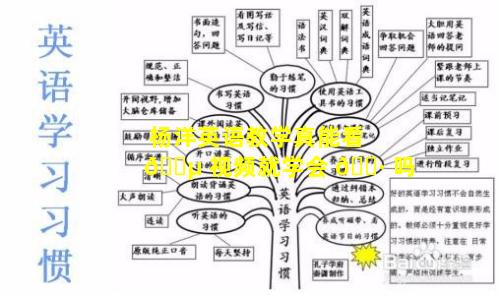D老师的英语教学方法效果究竟如何
- 作者: 刘雨檐
- 来源: 投稿
- 2024-10-01
1、D老师的英语教学方法效果究竟如何
评估 D 老师英语教学方法效果的因素:
学生成果:考试成绩(例如,课堂测验、中期考试、期末考试)
学生的英语沟通能力(口说和写作)
学生的阅读理解和语法知识
课堂观察:教师的课堂管理和参与技巧
教师使用的教学策略和活动的多样性
学生在课堂上的参与程度和互动性
学生反馈:学生对教学方法的满意度调查
学生在课堂上的非正式观察和见解
其他考虑因素:课堂的规模和组成
可用资源和材料学生的学习风格和需求
具体的评估方法:课堂观察:聘请一位经过认证的观察员评估 D 老师的课堂活动,并记录学生参与程度、教学策略和课堂互动。
学生成绩分析:比较学生在 D 老师课堂上的考试成绩与其他英语课堂或标准化考试的成绩。
学生反馈调查:向学生发放匿名的调查问卷,收集他们对 D 老师教学方法的意见和建议。
非正式观察:在课堂上进行非正式观察,记录学生与老师的互动以及学生的反应和学习成果。
比较分析:将 D 老师课堂的学生成果与使用不同教学方法的英语教师课堂的学生成果进行比较。
有效性评估的考虑因素:
使用多个评估方法可以提供更全面的评估。
数据应该在一段时间内收集,以避免一次性事件的偏见。
评估的重点应放在学生学习成果和参与度上,而不是教师的行为上。
评估结果应与利益相关者沟通,包括学生、家长和学校管理人员。
根据评估结果对教学方法进行调整和改进是至关重要的。
2、d老师的英语教学方法效果究竟如何
评估 d 老师英语教学方法的有效性的方法:
1. 学生学习成果数据:
比较学生在课程开始和结束时的考试成绩。
追踪学生在标准化考试中的表现(例如,TOEFL 或 IELTS)。
监测学生英语技能的进步(例如,阅读、写作、听力和口语)。
2. 学生反馈:进行学生调查以收集对教学方法的反馈。
与学生进行焦点小组讨论,探讨他们的学习体验。
征求个别学生的意见,以了解他们的见解和建议。
3. 同行评审:邀请其他英语教师观察 d 老师的课堂。
让同行教师分析 d 老师的教学方法和提供反馈。
参与专业发展研讨会,讨论有效的教学实践。
4. 教师自省:d 老师应定期反思其教学方法。
评估学生的学习成果和反馈,并做出相应的调整。
参加专业发展课程或研讨会,以增强其教学技能。
5. 其他指标:学生的出勤率和参与度。
家长的反馈。课程的受欢迎程度和保留率。
有效英语教学方法的特征:
专注于沟通:强调使用英语进行实际交流。
以学生为中心:根据学生的学习风格和需要定制教学。
基于任务:使用真实的情景和任务来提升学习。
提供明确的反馈:定期向学生提供建设性的反馈,以促进进步。
促进反思:鼓励学生反思自己的学习并制定改进计划。
利用技术:融入技术工具以增强学习。
建立积极的学习环境:营造一个鼓励学习和参与的积极课堂氛围。

3、英语老师分享教学方法,教育心得
教学方法分享1. 互动式学习:
使用小组活动和讨论,让学生参与到课堂中来。
鼓励学生分享想法和观点,营造一个积极主动的学习环境。
2. 体验式学习:
通过角色扮演、模拟和真实场景来让学生体验语言。
这样可以提高他们的理解力、流利度和信心。
3. 技术整合:利用在线资源、互动软件和语言学习应用程序来补充教学。
这可以提供额外的练习、互动和便利性。
4. 分层教学:根据学生的不同水平和需求,调整教学内容和方法。
这样可以确保每个学生都在自己的学习水平上受到挑战和支持。
5. 个性化学习:
根据学生的兴趣和目标,为他们提供量身定制的学习体验。
这可以提高学生动力,让学习变得更加有意义和吸引人。
教育心得1. 营造积极的学习环境:
建立一个包容、支持和无压力的课堂氛围。
鼓励学生犯错并吸取教训,而不是害怕犯错。
2. 激发学生的兴趣:
通过与学生的生活相关的话题和活动来让英语学习变得有趣。
找到能激发他们好奇心和学习欲望的方法。
3. 重视沟通:创造机会让学生练习口语和写作技能。
强调语用学和文化意识,以便学生能够有效地使用语言进行交流。
4. 培养批判性思维:
引导学生质疑、分析和评估信息。
鼓励他们提出问题、寻找证据并形成自己的观点。
5. 持续专业发展:
作为一名英语老师,不断地提高自己的技能和知识。
参加研讨会、阅读专业期刊并与其他老师合作以保持学习和进步。
4、英语老师的教学方法英语作文
As an English teacher, it is essential to employ effective teaching methods that cater to the diverse needs of students and foster their linguistic development. Here are some pedagogical approaches that I have found to be particularly beneficial:
Communicative Language Teaching (CLT)
CLT places emphasis on realworld language use, prioritizing communication and interaction. I create opportunities for students to engage in meaningful conversations, discussions, and roleplays, allowing them to practice their speaking and listening skills in authentic contexts.
TaskBased Learning (TBL)
TBL involves engaging students in meaningful tasks that require them to use English for realworld purposes. I design tasks that focus on specific language functions, such as problemsolving, decisionmaking, or information sharing. This approach helps students connect language learning to practical applications.
Differentiated Instruction
Recognizing that each student learns differently, I employ differentiated instruction to meet their diverse learning styles and abilities. I provide varying levels of support, activities, and resources, enabling each student to progress at their own pace.
Technology Integration
I leverage technology to enhance student engagement and cater to diverse learning preferences. I utilize online language learning platforms, interactive games, and multimedia resources to support learning both inside and outside the classroom.
Personalized Learning
I prioritize creating a personalized learning environment where students feel supported and their individual needs are met. I regularly assess their progress, provide individualized feedback, and offer tailored support to help them achieve their language learning goals.
Emphasis on Fluency and Accuracy
While accuracy is important, I also focus on fostering fluency in my students. I provide ample opportunities for them to practice speaking and writing, gradually increasing the level of complexity and accuracy as they progress.
Cultural Immersion
Learning English involves more than just language acquisition; it also includes an understanding of the culture. I incorporate cultural insights into my lessons, exposing students to authentic texts, videos, and images that reflect the target culture.
Collaborative Learning
I encourage students to work collaboratively in pairs or small groups. This fosters peer learning and allows them to benefit from diverse perspectives and experiences.
Reflective Practice
I am committed to continuous improvement and regularly reflect on the effectiveness of my teaching methods. I seek feedback from students and colleagues to identify areas for growth and make necessary adjustments.
By employing these varied teaching approaches, I strive to create an engaging and supportive learning environment where students can develop their English language skills effectively and confidently.




